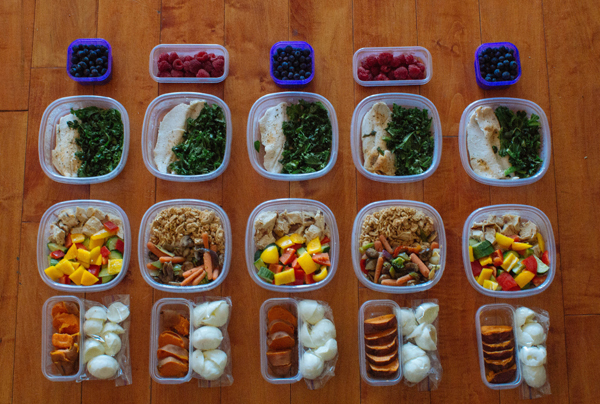Welcome to week one of the #backtoschoolchallenge2015. In this 30-day challenge you’ve probably made the assumption in order to win you’ve got to tighten up your diet by restricting your calorie-intake and up’ing your workouts.
That mindset is not exactly accurate. While you do have to tighten up your diet, you shouldn’t mindlessly restrict your food intake; especially if you are going to be working out more.
Here’s a happier compromise: Eat more quality foods and eat them more often. Spreading six smaller meals across your day operates on the simple principle of satisfaction. Frequent meals tame the slavering beast of hunger.
The secret? Each mini meal should blend protein and fiber-rich complex carbohydrates. According to the American Dietetic Association (ADA), “Protein and fiber give you that feeling of satiety and keep you from feeling hungry.”
Controlling hunger can and will shrink your stomach. Recently, the International Journal of Obesity, ran a study where one group of overweight men was given five small meals, then was free to choose a sixth meal.
The second group ate a single meal containing the same number of calories as the total of the other group’s first five meals, then later had a free-choice second meal.
The six-meal men ate 27% less food at their last meal than the two-meal men did at their second.
Another benefit to consistent eating is it will also keep your protein levels high, therefore helping you build muscle. Studies have found that your body can metabolize only so much protein at one time and is better metabolized better when divided evenly.
The challenge? Keeping your meals actually small because you do not want your mini meals to exceed what you would eat in three larger meals.
With a suggested calorie count in hand, you can mix and match from the list of meals shown here. (Ask an Elite Trainer for help if you need help calculating your suggested calorie intake.) Follow these guidelines during the next 30 days, as well as meal prep the weekly challenge recipes and commit to the workouts to see results.
Breakfast: 6-8:30 a.m.
Keep it simple and mix protein and quality carbs. The ADA states when protein is included in a meal, not only does it help prevent overeating at other times of day, but it also sustains energy levels and improves concentration.
Do not leave home without breakfast—this is the foundation for the rest of your day. On super-hectic mornings this can mean simply choosing a milk-infused latte instead of plain coffee (avoid sugary additions), or a tablespoon of peanut butter on an English muffin.
- 110 calories: Latte with reduced-fat milk
- 200 calories: 1 cup reduced-sodium cottage cheese with fresh peaches and cinnamon
- 200 calories: 1 cup blackberries, blueberries, or strawberries with 6 ounces light yogurt and 1 tablespoon low-fat granola
- 250 calories: Egg (anyway you like it) on a whole-grain English muffin with melted cheese
- 250 calories: Oatmeal made with milk instead of water; add brown sugar, walnuts, and/or any fresh or dried fruit
- 300 calories: Peanut butter on a whole-grain English muffin
- Two-egg omelet with spinach, mushrooms, and feta cheese
Morning Snack: 9:30-10:30 a.m.
Planning matters buy the foods you need and avoid the junk at work. Keep a stash of string cheese, granola bars, trail mix at your desk.
- 80 calories: Stick of string cheese
- 100 calories: Hard-boiled egg with a handful of grape tomatoes
- 180 calories to 250 calories: Nature Valley granola bar or Clif Bar
- 275 calories: 2 or 3 small handfuls of trail mix
- 300 calories: Slice of whole-grain bread topped with peanut butter and banana
Lunch: 12-1:30pm
Around lunchtime be extra cautious of your food intake. If you’ve had only a latte, fruit, and some string cheese so far, go ahead and have a big lunch. But if you’ve already eaten 700 calories, keep lunch light.
- 175 calories: Canned tuna with balsamic vinegar on whole-grain crackers or bread
- 350 calories: Half an avocado, sliced, or ½ cup prepared guacamole with tomato and onion in a whole-grain pita
- 400 calories: 3 or 4 slices of bacon, reduced-fat Cheddar cheese, thin apple slices, and peanut butter on toasted whole-grain bread
- 400 calories: ½ cup hummus with roasted vegetables
- 400 calories: Small ham-, turkey-, or roast-beef-and-Swiss wrap with vegetables and mustard, in a whole-wheat tortilla
- 400 calories: Fresh mozzarella and tomato slices on a bed of greens, with balsamic vinaigrette and extra-virgin olive oil
Afternoon Snack: 2:30-3:30pm
Steer clear of the candy bowl and think to yourself: you could eat four small chocolates for 100 calories or you could eat a cup of yogurt.” The chocolate gives you hardly any protein; the yogurt delivers at least 8 grams.
- 100-120 calories: 1 container of nonfat Greek yogurt
- 160 calories: Reduced-fat Cheddar melted on apple halves
- 175 calories: 5 Laughing Cow cheese wedges
- 200 calories: ½ cup hummus with vegetables
- 250 calories: Small handful of chopped pecans over a cup of fruit salad
- 260 calories: Apple, pear, or banana smeared with peanut butter
- 340 calories: 2 ounces roasted nuts
- 350 calories: 1 cup each fat-free milk and frozen yogurt blended with a spoonful of peanut butter
Dinner: 5:30-7:30 p.m.
Reining in meal sizes at Dinner will seem strange but portion control can make or break the plan. Remember—you’ll be eating again in 2 hours.
- 200 calories: 2 cups mixed vegetables (fresh or frozen) with ½ cup marinara sauce and some grated Parmesan cheese
- 275 calories: 3 or 4 large handfuls of greens sautéed in olive oil with a handful of walnuts and ½ cup raisins
- 300 calories: 6-piece sushi meal with a cup of miso soup
- 350 calories: Quesadilla made with a small corn or whole-wheat tortilla, cheese, beans, shredded chicken or lean ground beef, onion, and jalapenos, and dipped in salsa
- 400 calories: Slice of pizza topped with cheese and ground beef or ham
- 400 calories: Turkey London broil cut into strips, sautéed with onion, red and orange bell pepper, and teriyaki sauce
- 450 calories: Small plateful of nachos—baked tortilla chips, shredded reduced-fat cheese, refried beans, and salsa (plus some corn or black beans, if you want)
- 550 calories: 1 cup pasta tossed with browned ground turkey breast, black olives, diced onion, a drizzle of olive oil, and 1 ½ tablespoons crumbled Gorgonzola cheese
Evening Snack: 8:30-10 p.m.
If your feeling famished by the end of your day, your calorie count is too low. Adjust it by adding more sensible foods to your plan. Or try choosing higher-fiber foods; they’re digested slowly, so they’ll help you feel fuller longer.
- 150 calories: 5 cups Jolly Time light microwave popcorn sprinkled with hot sauce and/or 1 tablespoon Romano cheese
- 150 calories: 6 or 7 strawberries dipped in yogurt and drizzled with chocolate sauce
- 150 calories: 1 cup cocoa made with skim milk
- 175 calories: Sliced sweet potato (with skin), tossed in olive oil and baked
- 175 calories: 1 cup skim ricotta cheese sweetened with Splenda, vanilla flavoring, and a dash of nutmeg or cinnamon
- 175 calories: Seltzer with 2 scoops frozen yogurt, a handful of berries, and a shot of flavoring syrup, such as strawberry or cherry


